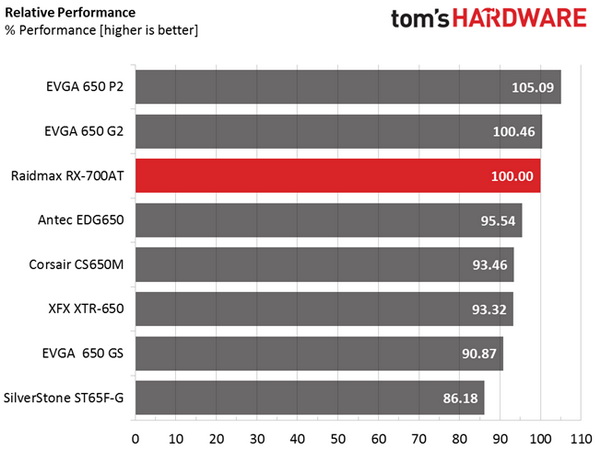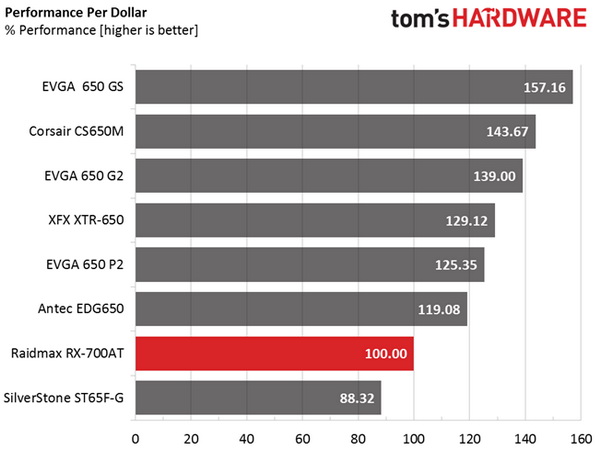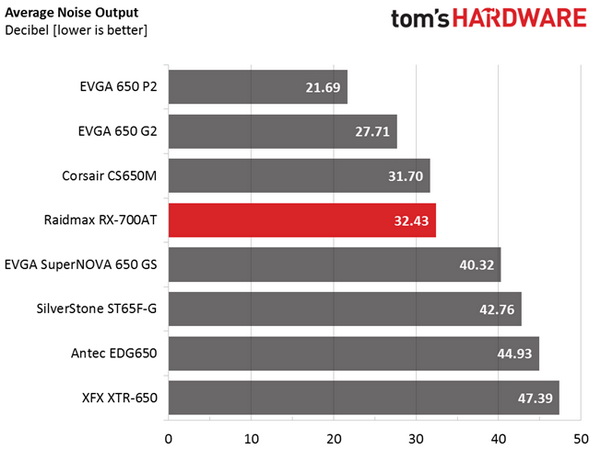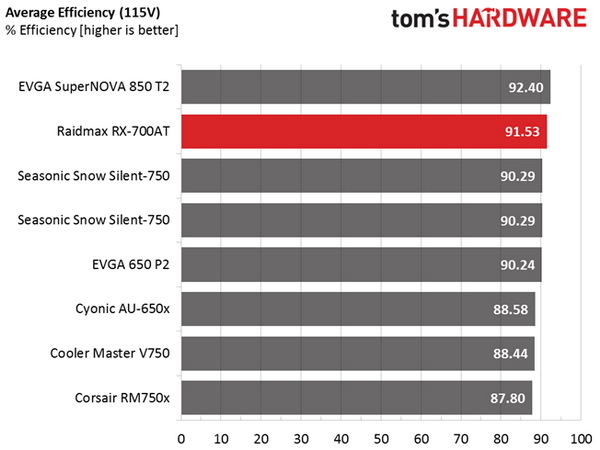Raidmax Monster RX-700AT Power Supply Review
Raidmax is the first company to utilize Andyson's new Titanium platform with its Monster RX-700AT PSU. This is a semi-modular unit with a double ball-bearing fan and Japanese capacitors, promising high performance and exceptional efficiency.
Why you can trust Tom's Hardware
Performance, Performance Per Dollar, Noise and Efficiency Ratings
Performance Rating
The following graph shows the total performance rating of the RX-700AT, comparing it to other units we have tested. To be more specific, the tested PSU is shown as 100 percent, and every other unit's performance is shown relative to it.
Although this is a high-performance power supply, it isn't able to beat EVGA's Gold- and Platinum-rated offerings, mostly because the latter feature top-notch ripple suppression.
Performance Per Dollar
The following chart may be the most interesting to many of you because it depicts the RX-700AT's performance-per-dollar score. We looked up the current price of each PSU on popular online shops and used those prices and all relative performance numbers to calculate the index. If the specific unit wasn't available in the United States, we searched for it in popular European Union shops, converting the listed price to USD (without VAT). Note that all of the numbers in the following graph are normalized by the rated power of each PSU.
The MSRP that Raidmax gave us is very high, so the RX-700AT scores poorly. Street prices should be significantly lower, but then again, this is why we prefer to review products already available to our readers.
Noise Rating
The graph below depicts the cooling fan's average noise over the PSU's entire operating range, with an ambient temperature between 28 °C and 30 °C (82 °F to 86 °F).
Under light and moderate loads, and under normal operating temperatures, the RX-700AT is silent. However, its fan profile could be much more relaxed given such high efficiency and modest thermal loads.
Efficiency Rating
The following graph shows the average efficiency of the PSU throughout its operating range with an ambient temperature between 28 °C and 30 °C.
Get Tom's Hardware's best news and in-depth reviews, straight to your inbox.
As you might expect, efficiency is very high. The RX-700AT loses only to the super high-end EVGA 850 T2, which uses a cutting edge platform with a bridge-less design.
Current page: Performance, Performance Per Dollar, Noise and Efficiency Ratings
Prev Page Ripple Measurements Next Page Pros, Cons And Final Verdict
Aris Mpitziopoulos is a contributing editor at Tom's Hardware, covering PSUs.
-
vladm007 You can see the level of faith Raidmax has on the quality by having a 2 years warranty.Reply -
g-unit1111 Reply17870964 said:You can see the level of faith Raidmax has on the quality by having a 2 years warranty.
Yeah that's kind of a deal breaker. :lol: -
turkey3_scratch Another unit cheating on the PWR_OK tests. I'm sick of this crap. Also, those caps on the modular board don't look like Chemi-Con polymers, they look like electrolytics (not that it matters, I'm just questioning if you made a wording error). I also don't like the lack of a thermistor at all. That's some really high inrush current. They could have dished out some cash for one and a relay. I also think the warranty needs increased, but realistically it should last a lot longer than 2 years.Reply -
powernod Reply17871369 said:Another unit cheating on the PWR_OK tests. I'm sick of this crap. Also, those caps on the modular board don't look like Chemi-Con polymers, they look like electrolytics (not that it matters, I'm just questioning if you made a wording error). I also don't like the lack of a thermistor at all. That's some really high inrush current. They could have dished out some cash for one and a relay. I also think the warranty needs increased, but realistically it should last a lot longer than 2 years.
Exactly my thoughts! ;)
Failure at Power_OK signal & huge amount of inrush current = Deal-breaker for me :pfff: -
Aris_Mp if they provide a 5-year warranty and work on the price it has potential. The inrush current is an easy fix with a relay-bypass relay, however the lower than the required hold-up time isn't so easy addressable. A larger bulk cap will need more Amps to charge and more Amps lead to increase power losses, so efficiency will take a hit.Reply -
basroil Very close to be very good, and then it fails at the holdup time... looks like there's still only two real PSU manufacturers (seasonic and superflower)Reply -
Sakkura Why would anyone wonder why Raidmax only has a 2-year warranty? With the junk they've released in the past, it's a miracle they provide any warranty at all.Reply -
g-unit1111 Reply17872208 said:if they provide a 5-year warranty and work on the price it has potential. The inrush current is an easy fix with a relay-bypass relay, however the lower than the required hold-up time isn't so easy addressable. A larger bulk cap will need more Amps to charge and more Amps lead to increase power losses, so efficiency will take a hit.
I think any warranty above 5 years is kind of redundant. In 7 or 10 years you won't have that PSU anyways since you'll be replacing it with something new to keep up with new tech. 5 years I would say is about the length of time a warranty should be. -
turkey3_scratch Reply17872463 said:Very close to be very good, and then it fails at the holdup time... looks like there's still only two real PSU manufacturers (seasonic and superflower)
Superflower cheats on holdup time on various units. Look at the Leadex Gold 550. The 650 G2 also is a problem most likely, and the 750 G2. -
firefoxx04 I've used their cheaper units 3 times. One failed, however, it's environment was a worst case scenario. Very hot Michigan summer with no ac, dusty room, and almost always running the system with 100% cpu and gpu load.Reply



